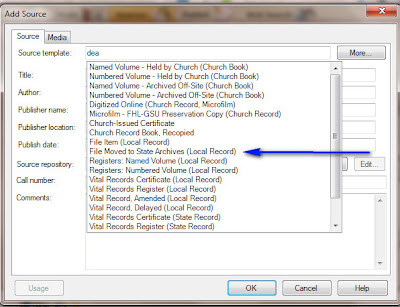The Free Form, non-Template Reference Note looks like this:
Johnson, Daniel F., compilier, New Brunswick, Canada Newspaper Vital Statistics, Provincial Archives of New Brunswick, P.O. Box 6000, 23 Dineen Drive, Fredericton, NB, Canada E3B 5H1; http://www.archives.gnb.ca, Vol 19, #45, The Gleener and Northumberland Schediasma, Chatham, Northumberland County, 27 Jul 1861, death of Isaac Leighton. Digital image of transcription downloaded 31 Jul 2012.So, I went to the website to see what I was looking at. We know where this document is, that is,Provincial Archives of New Brunswick, where I did a search for Isaac Leighton.
So, I downloaded the Image.
Now, which Template to use.
I am looking at a Death Certificate found on a website.
I looked at the "fine print" at the bottom of that page.
Appears that this an official Death Certificate that is in the New Brunswick (Canada) Archives and it's online.
I go into Family Tree Maker, Sources Workspace, and select Add, then New
This will bring up the screen where you select the Template. I entered "dea", keyword for death certificate. That will bring up a list of Templates that might be appropriate for a Death Certificate. I select File Moved to State Archives (Local Record). Reason, that this document was in Northumberland before it was sent to the Archives. At this point, I do NOT KNOW that, as I am not familiar with the details of these Canadian Records, but that is what appears to be the case.
Looking at the input screen, and the data requested, this did not appear to be appropriate. So, I changed the Keyword search to "ONL" for Online. The was a long list to select from, when I saw Canada.
The following screen came up and filled it in with information from the website.
That is the Template for that website. Database Online - National Archives (Canada). Clicking on OK, will bring up the Citation Screen.
Filling is the screen, based on what is shown in the above screen (slightly gray). That captures that information from that image for a Citation.
For this example, there was no additional information to put into the Citation Text.
The Reference Note now looks like this:
Provincial Archives of New Brunswick, "Vital Statistics from Government Records (RS141)", database, Provincial Archives of New Brunswick (www.archives.gnb/ca), Provincial Returns of Deaths, Northumberland County; Code 1961E, Reference C4/1916, Microfilm F18738; Isaac Robert Leighton, age 79, date 1916-01-12; accessed 29 August 2012.From there, the Image is attached and each Fact, with information from that Image, is linked to this Citation.
_______________________________________________________________
Copyright © 2012 by H R Worthington














